
The Bottom Line
Introduction, Specifications, and Pricing
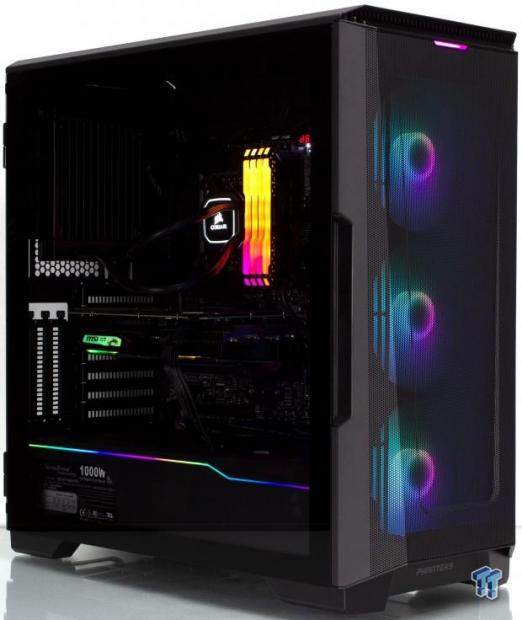
Phanteks is familiar to most who read our reviews at this point, as they have proven themselves to make some very cool and great performing chassis. Today we look at one of their newest entries, which happens to be launching today as well.
Today Phanteks releases what I think most of us knew was coming with the Eclipse P500A. This is another airflow focused chassis in the Eclipse lineup. The P500A is a high-end option made by fusing elements of both the P600S and the Evolv X chassis to make a great value performance option, which we will be checking out today.
Some of the key features I think will be important for the P500A is as follows:
- ARGB Fans and lighting features
- Versatile drive mounting
- Vertical GPU support
- Dual system option (With optional secondary system tray)
- Abundant liquid cooling support
- Mesh front for airflow performance
This is not everything the chassis can do but gives you a good idea of the features and capabilities of the P500A.

The P500A comes in three variants. Two with ARGB/DRGB fans and lighting stripe on the PSU cover along with the standard version, which has black non lit fans. The SKU breakdown is as follows:
- PH-EC500ATG_BK (2x 140 mm Black Fans)
- PH-EC500ATG_DBK (3x 140 mm D-RGB Fans)
- PH-EC500ATG_DWT (3x 140 mm D-RGB Fans)
As you can see, there is the standard version with dual black fans or two versions of the ARGB/DRGB version. The difference between the two is the chassis color, which is white or black. This can be discerned by the WT or BK suffix on the part number.
Motherboard fitment is from ITX to EATX measuring up to 280mm width. HDD fitment out of the box is up to 2x 3.5" drives and 3x 2.5" drive trays included. The P500A can fit up to ten 3.5" drive trays should you want them; the trays can be purchased separately (PN: PH-HDDKT_03) form Phanteks to fully outfit the chassis.
PSU fitment is virtually unlimited if you do not install drive trays in the area under the PSU shroud. However, if you do, you can fit up to 250mm PSU with two trays at the bottom or up to 195mm with four trays installed. I think you are safe to say no arbitrary limit as you can shuffle storage to fit a huge PSU if you happen to have one. The PSU shroud is worth mentioning as well, as it has an ARGB accent stripe if you get the ARGB/DRGB model.
Cooling fitment is massive as well with fitment for up to seven 120mm fans or six 140mm. Radiators you can fit up to a 420mm or 360mm up front, while the top can fit up to 360mm or 420mm. CPU cooler height limit is 190mm, so no real limit there either. The chassis we have today being the ARGB/DRGB version comes with three 140mm front fans, which are DC 3-pin variant.
The price for the ARGB variant, as we are looking at today, carries an MSRP of $129.99, while the base model with two black fans comes in with an MSRP of $99.99. This places the P500A in the same range as the Thermaltake S500, the Masterbox MB530P, and the Mastercase H500. These are all competent chassis, so it will be interesting to see if the P500 has the moxie to earn a recommendation among this sort of competition.
Shannon's Chassis Test System Specifications
- Motherboard: ASUS ROG Maximus XI Hero (Wi-Fi) Z390 (buy from Amazon)
- CPU: Intel Core i7 8700K (buy from Amazon)
- Cooler: Corsair Hydro Series H60 (buy from Amazon)
- Memory: Corsair Vengeance Pro RGB CMW32GX4M4C3000C15(buy from Amazon)
- Video Card: MSI GeForce RTX 2060 Gaming Z (buy from Amazon)
- Storage: SanDisk M.2 256GB
- Power Supply: SilverStone Strider Platinum 1000W (buy from Amazon)
- OS: Microsoft Windows 10 Home 64-bit (buy from Amazon)
Packaging


The larger sides of the box for the P500A starts with the name and a partial frontal profile of the chassis. The top and bottom of this side have designs that mimic the grille at the top and bottom of the eclipse series, which is a cool piece of attention to detail.


The two opposing small edges have the rest of the frontal profile, along with the opposing side having the inventory control labels.

The P500A comes in a black fabric bag to help avoid abrasion damage. The ends are enveloped in soft squishy polypropylene style foam caps. These caps are also reinforced with cardboard, which makes it even better for rigidity along with holding its shape.
Phanteks Eclipse P500A Mid-Tower Chassis

The front being a mesh panel, we get excellent visibility of the preinstalled ARGB fans. The front mesh has a sizeable aesthetic indentation to give the panel some styling lines. The top still carries the Eclipse grille styling like the box shows.

The top of the P500A is where we look next, and we see that a magnetic filter covers the ventilation. The I/O is along the top right side of the panel.

Here we see the I/O of the P500A and it is equyipped as follows:
- Headphone/Microphone 3.5mm jack
- 2x USB 3.2 Gen 1 Type-A ports
- USB 3.2 Gen 2 Type-C port
- LED color button
- LED mode button
- Power button
The P500A has an adequate I/O with high-speed connectivity and a full Gen 2 Type-C port. The RGB mode and color buttons are used to control the fans and onboard RGB of the chassis. A long press on the mode button will sync the chassis to the motherboard or other ARGB controller if you have it connected to the 3-pin internal connector.

The main panel is a tempered glass variety and held closed by powerful magnets. This chassis door doe not open on its own or by mistake. We can also see the accessory package inside as well.

The rear of the P500A is quite similar to many chassis we have seen. However, at the top, you will see a metal strip, and this is covering where the secondary system tray will be mounted should you opt for this option. The vertical mount supports up to three slots with still a bit of room to the glass panel. The distance between the I/O shield cutout and the rear panel tells me this chassis is going to have a lot of room for cable management. Also, note the PSU has a removable bracket as the PSU is meant to slide in from the rear.

The cable management side of the P500A is a solid steel panel, so there is not much to see here. However, it is worth noting that the panel is quite thick and very rigid, so it has a very robust and quality feel to it.


The bottom of the P500A is flat steel. The panel has several cutouts to fit the HDD trays, which can snap into the chassis floor if needed. The removable PSU dust filter is in place at the rear and pulls out from the back. As you can see, when the filter is removed, the airflow is wide open.
Inside the Eclipse P500A

The front panel pulls off quite quickly as it uses six ball and socket style attachment points. The top of the chassis has the ARGB LED array, which lights the front indicator. The fan mounting, as you can see, is slotted and capable of 120mm or 140mm mounting but is occupied by the preinstalled 140mm trip of ARGB fans.
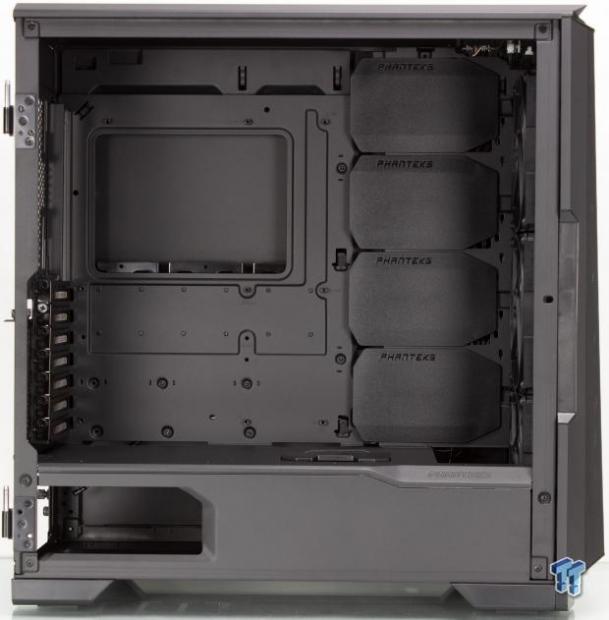
The inside of the P500A is wide open and very tidy thanks to the cable covers to the right, which can slide to allow cables passing through as needed. These can also be removed to equip HDD cages in this area, like shelves. Also of note is the CPU backplate cutout, which is massive.
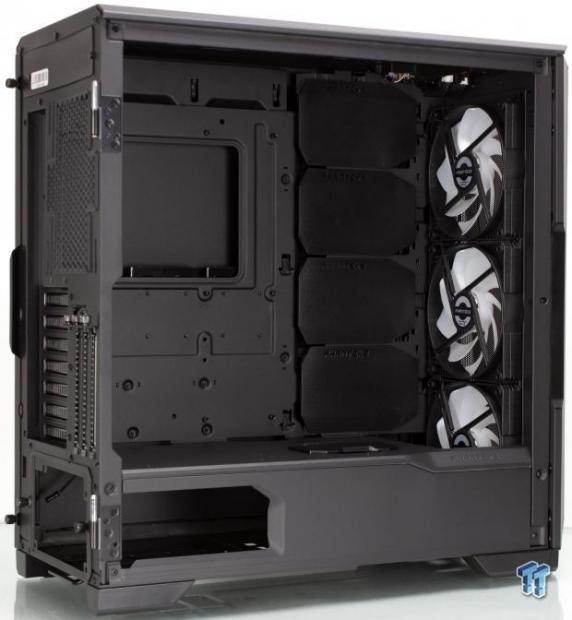
Here we get a shot inside the front of the P500A. Here we can see the trio of fans which passes into the PSU chamber, and there is extra room in the PSU shroud for a radiator with fans to go down here for additional clearance.

Here we have removed the filter, and now the mounting for top cooling is revealed. The top mounting supports dual 140 or triple 120mm cooling, and the fact that the gap between this area and the motherboard is so large, there should be no issue fitting a radiator here. However, if you have a thicker radiator, you may want to measure a bit before buying your radiator model.

Here we have the PSU shroud, and it has a window where you can see your PSU inside. There is also a sliding cover midway into the shroud where you can pass GPU cables to the PSU chamber. In the front, we can see the larger opening to ensure a radiator and fans can pass through to the PSU chamber.
Inside the P500A Continued

The rear of the P500A has 120mm or 140mm mounting, but no fan equipped out of the box. We will be installing our test AIO here, but if you buy the P500A, you may want a fan here. The expansion card mounting screws are easily accessible internally thanks to the cutout of the chassis rail to allow easier access with screwdrivers.
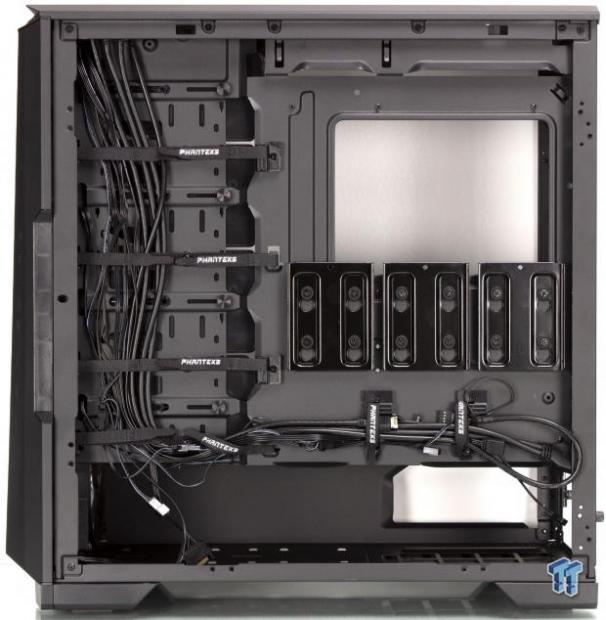
The cable management area is fantastic, in my opinion. The vast array of Velcro fan tie-downs is a great advantage to clean up a build without the need for zip ties for the most part. We also see the triple 2.5" drive trays on the motherboard tray along with eth massive open space below the PSU shroud, which can house the 3.5" trays. There are tons of cable passthrough holes as well, which will undoubtedly make the build process much more manageable.

Here we see inside the PSU chamber area where you can snap drive cages in place to install 3.5" drives if you find the need for it.

The PSU area is quite standard with the rear bracket coming off so the PSU can slide in from the rear. The floor of the chassis has flat ridges pressed inward to the chassis to make an area for the PSU to rest onto. The airflow cutout for the PSU looks to be adequate for most PSU faans, but if yours is further to the front, it should still be fine as the PSU is raised from the floor, so it will still get air.

The cabling is reasonably straightforward, with all of the necessary connectors present.
- Power switch connector
- 3-pin 5V ARGB connector (allows sync to motherboard or controller)
- SATA power connector (for internal RGB controller)
- HD audio connector
- 20-pin USB 3.2 Gen 1 connector
- USB 3.2 Gen 2 connector
The connections not shown are three 3-pin fan headers for the fans, along with the RGB cabling for the controller and the fans.
Hardware & Documentation

The accessory package is an interesting array of parts which we will list below.
- 2x 3.5" HDD brackets
- Anti sag GPU bracket
- Vertical GPU mount
- 6x zip ties
- Fastener plastic box
The plastic organizer box of fasteners contains the following:
- 22x motherboard screws
- 12x thumb screws
- 8x fan screws
- 8x HDD screws
- Standoff tool
- motherboard standoff
- 7x PSU screws
- 6x case screws
- 3x riser screws
- 4x standoffs (secondary system tray)

The manual for the P500A is a multi-fold large sheet which covers the basics of building in the P500A. The guide does an excellent job of showing the chassis features and functions as well. There is also a card telling users to contact Phanteks if they have any RMA or support concerns.
Case Build & Finished Product

The front of the P500A when powered off. We can kind of make out components are in there, but mostly it looks the same.
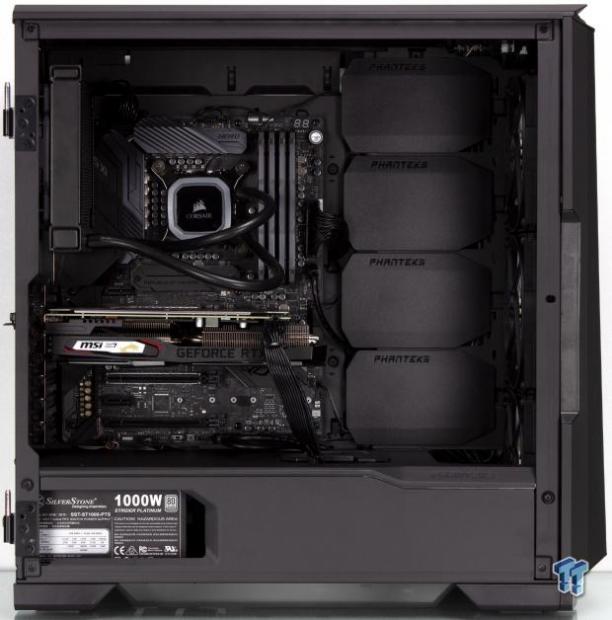
Everything went in smoothly as you can see, there's tons of spare space available inside the chassis chamber. Now, if you were making a mass storage or home server rig, then the story would change as the area toward the front could be stuffed with HDD bracket trays. The cable covers do a great job of hiding all of the cables behind them, making the inside extremely clean.

The rear I/O is filled as expected with our test system. There is still so much more capability with this chassis if we went for a dual system or more GPUs; this could fill in far more.
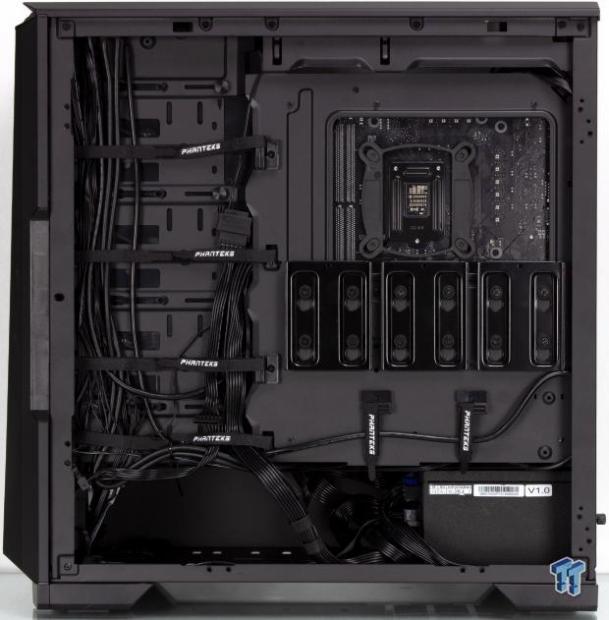
The cable management in the P500A is, dare I say effortless. Well, I guess it takes some work to figure out which Velcro area you want to run through,l but otherwise, it is simple. I only used one zip tie at the bottom to manage the USB 3.2 Gen 1 cable as it was being unruly and would not bend to my will.


With the system powered off, it looks very stealth; however, you power it on, and the unicorn show takes off. The RGB can be synchronized or even solid color depending on your want. I left it at the rainbow setting to show the spectrum capabilities of the RGB strip on the PSU shroud and the fans.



Phanteks sent over some new fans they offer to showcase the accessories they provide for the P500A. These are their new SK PWM fans, which come in standard black, along with semi-opaque white, which is DRGB/ARGB and uses the Phanteks connector to connect to their RGB controller in the case. We fit the 120mm SK PWM DRGB fan to our AIO just to showcase the aesthetic which much to my surprise not only enhanced the cooling on the CPU by 3C delta over ambient but also kept the interior of the chassis 5C cooler and the GPU 2C cooler by helping yank warm air from the chassis.
Final Thoughts
When I first heard about the P500A from Phanteks, it looked like a pretty impressive new chassis with excellent cooling. However, once I got my hands-on it, I realized it was not only a great performer but very well built and structurally sound enough I would trust standing on it. That is not a statement I make about many chassis.
Thermal performance is one of the best we have tested with a measured ambient of 24.5C and an RH of 43%. The P500A with our testbench installed saw an average delta over ambient for the CPU of 48.1C, and the GPU showed an average delta of 35.5C, which is one of the best GPU temps we have seen form any test we have had on the bench recently.

What we like
Build Quality: The P500 is a sturdy and stout platform to start your build. The material thickness and panel quality is top-notch and makes for a very sound and sturdy-feeling chassis.
Included ARGB: Both the fans and the strip on the PSU shroud along with the top front of the chassis are ARGB, all of them carrying a cohesive theme. The ability to synchronize with the rest of your system means the entire system will match.
Value: The quality, size, and feature set mean the P500A gets some value points here. The ability to have a second system internal with the purchase of an optional kit is a great way to do this. Phanteks keep from charging you for a bunch of accessories you may not use, but the option is there if you want it.
What do we think could be better?
2nd system rear cover: The lid at the top of the rear of the chassis, which covers the secondary system mounting, feels like an afterthought. It is a flat piece of metal that does not fit perfectly to the rear and makes it feel like something slapped in place to cover the hole rather than something designed into the chassis.
The P500A is an excellent value if its feature set matches your build needs. The feature set is stout for the price point and easily earns top marks for its class.
Shannon's Chassis Test System Specifications
- Motherboard: ASUS ROG Maximus XI Hero (Wi-Fi) Z390 (buy from Amazon)
- CPU: Intel Core i7 8700K (buy from Amazon)
- Cooler: Corsair Hydro Series H60 (buy from Amazon)
- Memory: Corsair Vengeance Pro RGB CMW32GX4M4C3000C15(buy from Amazon)
- Video Card: MSI GeForce RTX 2060 Gaming Z (buy from Amazon)
- Storage: SanDisk M.2 256GB
- Power Supply: SilverStone Strider Platinum 1000W (buy from Amazon)
- OS: Microsoft Windows 10 Home 64-bit (buy from Amazon)
Performance |
97% |
Quality |
97% |
Features |
97% |
Value |
96% |
Overall |
97% |
The new Eclipse P500A form Phanteks ticks a ton of the right boxes. The performance and rigidity of the chassis is tough to beat. Anyone looking for a robust chassis with more than enough space should consider the P500A.

Similar Content
Related Tags

